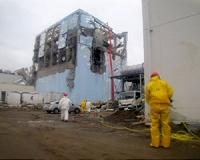 |
Tokyo (AFP) April 6, 2011 Workers at Japan's crippled atomic power plant on Wednesday plugged a hole spewing highly radioactive water into the ocean, boosting efforts to contain the world's worst nuclear disaster since Chernobyl. But in an illustration of how fragile progress is at the Fukushima plant, operator Tokyo Electric Power said it was concerned a build-up of hydrogen gas at a different reactor could cause another explosion at the site. The water leak was thought to be a source of spiking radiation levels in the sea, which prompted Japan to announce its first seafood radiation safety standards following the discovery of fish with high levels of contamination. TEPCO workers had injected sodium silicate, a chemical agent known as "water glass", to solidify soil near a cracked pit where water was escaping into the Pacific. The pit, which has a 20-centimetre crack in its wall, is linked to the plant's reactor No. 2, one of several that had their cooling systems disabled by a catastrophic earthquake-tsunami disaster on March 11. "Workers confirmed at 5:38 am (2038 GMT Tuesday) that the water running out of a pit had stopped," TEPCO said in a statement on Wednesday. Several unsuccessful attempts had been made to try to stop the leak, including an effort to seal the crack with cement. Radiation in the water leaking from the plant was measured at more than 1,000 millisieverts. The water is thought to be a source of radioactive iodine-131 readings in the sea that were more than 4,000 times the legal limit. Levels in seawater immediately outside the plant have spiked, and amid increasing unease about the contamination Japan on Tuesday imposed a legal limit for radioactive iodine in seafood for the first time. The stopping of the leak was the first piece of major good news for several days in the battle to control the crisis at the Fukushima plant. However, officials are concerned that a hydrogen build-up in the housing around reactor No. 1 could react violently with oxygen, creating an explosion. On Wednesday they announced plans to begin injecting nitrogen, an inert gas abundant in the atmosphere, which they hope will displace the oxygen. "We are considering injecting nitrogen into the container of the reactor number 1 because hydrogen gas has possibly accumulated in the container," a TEPCO official said. NTV reported that the operation could take place "as early as today". In the days after the earthquake and tsunami crippled the plant, large explosions resulted from hydrogen accumulation near the reactors, damaging the outer buildings housing them. A 20-kilometre (13-mile) exclusion zone around the plant has forced tens of thousands of people to evacuate. The plant has emitted radioactive material into the air, contaminating drinking water and farm produce, with radioactive iodine above legal limits detected in vegetables, dairy products and mushrooms. Nuclear concerns continue to distract from the March 11 disaster that has left more than 12,000 dead and over 15,000 missing. India on Tuesday banned all food imports from Japan, the first country to impose a blanket block. Several countries including China, Singapore and the United States have barred food from some Japanese prefectures. Fishing has been banned within 20 kilometres of the stricken plant, matching the radius of the evacuation zone on land. TEPCO continued a separate operation to release 11,500 tonnes of lower-level radioactive water into the sea to free up urgently needed storage space for water so toxic that it is hampering crucial repair work. Nuclear safety agency spokesman Hidehiko Nishiyama said the bulk of the water -- around 10,400 tonnes -- had now been released. The operation has met with condemnation from at home and abroad, with the government in Seoul describing it as "a pressing issue" for South Korea. Ikuhiro Hattori, the head of Japan Fisheries Cooperatives, on Wednesday visited TEPCO headquarters to protest the dumping. "This is unforgivable." he said, according to Jiji Press, as he met TEPCO chairman Tsunehisa Katsumata. "We need you to clarify who should take responsibility, either the state or TEPCO." Shares in the company -- Japan's biggest power utility -- continued their downward tumble Wednesday. They had fallen around 15 percent by midday, after plunging to 362 yen Tuesday -- their lowest ever close -- amid concerns the firm will face compensation bills of more than 10 trillion yen ($120 billion). The wider economic fallout from the quake, tsunami and nuclear crisis is likely to drive the country into recession in the coming months, many economists now say. The government is planning a first emergency budget of more than three trillion yen ($35 billion), Kyodo news agency reported, quoting ruling party politicians saying total spending could top 10 trillion yen.
Share This Article With Planet Earth
Related Links Space Technology News - Applications and Research
 Radioactive water leak into sea stops at Fukushima: Jiji
Radioactive water leak into sea stops at Fukushima: JijiTokyo (AFP) Apr 06, 2011 Radioactive water stopped leaking into the Pacific Ocean from Japan's crippled Fukushima nuclear plant Wednesday, Jiji Press reported, citing the operator Tokyo Electric Power Co. (TEPCO). TEPCO had on Tuesday injected sodium silicate, a chemical agent known as "water glass", to solidify soil near a cracked pit, from where large volumes of highly radioactive water had been seeping through an ... read more |
|
| The content herein, unless otherwise known to be public domain, are Copyright 1995-2010 - SpaceDaily. AFP and UPI Wire Stories are copyright Agence France-Presse and United Press International. ESA Portal Reports are copyright European Space Agency. All NASA sourced material is public domain. Additional copyrights may apply in whole or part to other bona fide parties. Advertising does not imply endorsement,agreement or approval of any opinions, statements or information provided by SpaceDaily on any Web page published or hosted by SpaceDaily. Privacy Statement |